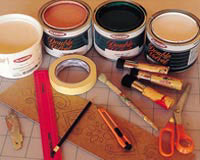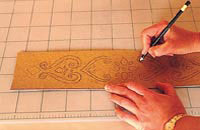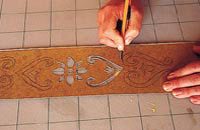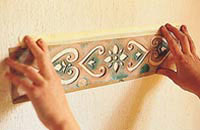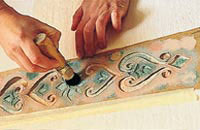Make your own stencils
Stencilling requires no artistic talent, although the end result is most impressive. Stencils are readily available from art and paint shops but can be copied or drawn. Designs can easily be enlarged using a photocopier.
YOU WILL NEED:
Stencil card or acetate - available from art and craft shops
Pencil
Tracing paper
Stanley knife
Stencil brush - clean brush for every colour
Scissors
Masking tape
Ruler
Stencil cutting board or any wooden board
HERE'S HOW:
1. Draw or trace the desired design onto a stencil card. Ensure that it is positioned accurately with sufficient card left between the cut out areas to make the stencil strong - leave 2 - 3mm bridges or ties. These parts will support the open internal sections of the design. Bear in mind where you wish to repeat the pattern and, if necessary, make registration marks as to where to begin the successive part of the frieze or border.
2. Using a Stanley knife, carefully cut out the design. Press on the stencil cutting board or any wooden board.
3. Attach masking tape to the top of the stencil and place it on the wall. Make sure the stencil is straight. In this instance, the stencil is placed above the painted stripes about 1m from the floor i.e. at dado rail level.
4. Dip a stencil brush in undiluted paint. Dab off the excess on a piece of newspaper.
GOOD TO KNOW
Do not overload the brush as the paint will bleed through beneath the stencil.
DIY TIP:
Experiment with the stencil and colour on a scrap piece of paper first.
5. Gently pounce the paint on, holding the brush at a 90º angle to the wall. Lift up the stencil to see how much paint has gone through. Apply the next colour in a similar manner. No drying time is necessary. More than one colour can be applied, but a separate brush must be used for each colour.
GOOD TO KNOW
Stencil brushes must always be totally dry when dipped into paint.
6. Move the stencil along to the next position on the wall and repeat. While accuracy is important, absolute continuity with the paint application is not essential.

